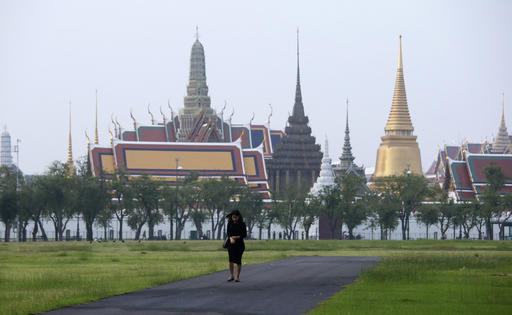Show me the money: Thailand’s mega-rich monarchy

A Thai woman dressed in black walks in front of Grand Palace in Bangkok, Thailand, Friday, Oct. 14, 2016. Grieving Thais went to work dressed mostly in black Friday morning, just hours after the palace announced the death of their beloved King Bhumibol Adulyadej, the politically fractious country’s unifying figure and the world’s longest-reigning monarch. He was 88. AP Photo
BANGKOK—Late Thai king Bhumibol Adulyadej has left behind one of the world’s richest monarchies, with a multi-billion-dollar empire spanning property, construction and banks.
Analysts say the vast royal reserves have allowed the crown to build a deep network among the Thai elite, helping insulate the king from the political pressures felt by monarchs who rely chiefly on state funding.
READ: Thailand’s King Bhumibol Adulyadej dies
But as with all issues linked to the Thai monarchy, the crown’s financial dealings are shielded from criticism by one of the world’s harshest lese majeste laws.
Even the king’s semi-official biography admits that the Crown Property Bureau (CPB), the banner under which the assets are held, is a “unique” and “rather mysterious institution”.
Article continues after this advertisementHere is what we know about the opaque but powerful palace purse.
Article continues after this advertisementHow rich is it?
The CPB is not obliged to release any details of its accounts or activities, so its precise assets are unknown.
But 2014 estimates by Porphant Ouyyanont, a Thai academic who has done landmark research on the CPB, put its portfolio at up to $59.4 billion — nearly four times richer than the British crown.
The CPB has invested in dozens of companies over the years, but the bulk of its returns come from land, banking and cement.
Company accounts show it holds a 23.69 percent stake in Siam Commercial Bank, the kingdom’s oldest bank, and a 31.6 percent stake in Siam Cement Company, a sprawling conglomerate that has paved Thailand’s urban expansion and branched out across the region’s growing economies.
The CPB is also one of the kingdom’s largest landlords with 40,000 rental contracts, half of which are in prime areas of Bangkok, according to the 2011 biography of Bhumibol published on the CPB website.
The book put the bureau’s returns — tax-exempt by law — at around $300 million annually.
Who holds the keys?
The CPB was initially placed under state control when it was formed in 1936, just a few years after absolute monarchy was abolished in Thailand.
But a decade later the keys were handed back to the king, giving him final say over any asset sales and power to appoint six out of seven board members.
The 1948 legislation also made clear revenue “may be disbursed only by the king”.
This reclamation of royal control came just after Bhumibol ascended to the throne, marking the start of a long, highly successful effort to revitalize the monarchy’s prestige and power.
READ: Key milestones in the life of Thailand’s King Bhumibol Adulyadej
By the time Thailand’s post-World War II economic boom was underway, the stability that came with palace backing made the CPB the most attractive partner for foreign firms flocking to the kingdom, embedding its control over the economy.
“In the 60s we were almost the only institution foreign investors spoke to,” the CPB’s director-general Chirayu Isarangkun, who declined to comment for this article, said in a rare 2012 interview published on the bureau’s website.
Where does the money go?
The bureau’s funds are used to cover the royal family’s expenses and the upkeep of palaces and other royal sites.
However the palace also receives millions of dollars from the government budget to foot a number of other expenses.
Around $170 million annually in state funding covers the salaries of staff working in the Royal Household Bureau and other key palace offices, plus security provided for the royals by police and armed forces, according to the king’s biography.
Public funds also cover many of the rural development projects that have been exhaustively promoted by the palace’s propaganda arm.
The CPB’s director-general has previously said the king prefers to use as little of the taxpayers’ money as possible.
“There is no sign that King Bhumibol ever used it as his own money pile,” said Paul Handley, author of “The King Never Smiles”, a biography of Bhumibol banned in Thailand.
He noted that the bureau is overseen by some of the country’s most trusted technocrats, and monitored by one board member from the Ministry of Finance.
The CPB has sought to spruce up its image in recent years and publicized a number of corporate responsibility and social development projects. But its financial activities are still largely shrouded in mystery.
“Ignorance breeds suspicion — yes. But excessive curiosity, I believe, can also lower a dignified and trusting relationship,” the bureau’s director was quoted as saying in the king’s 2011 biography.